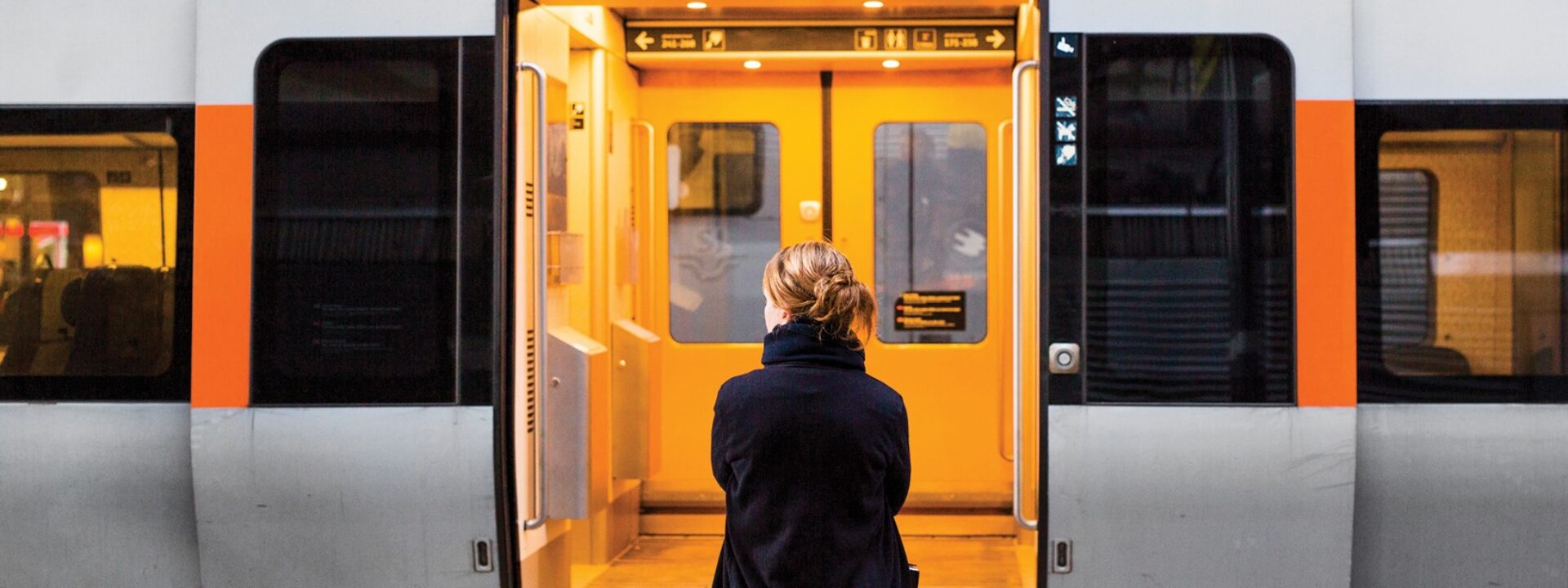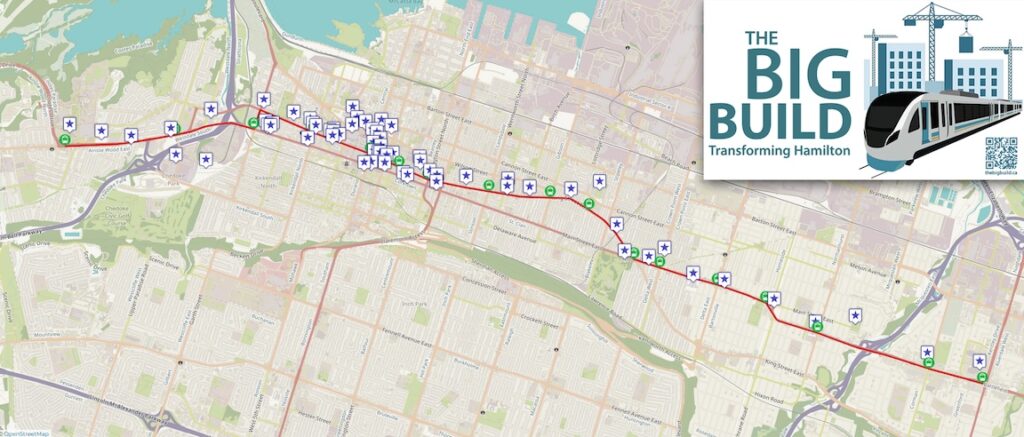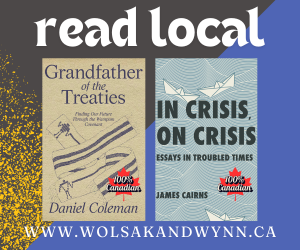Hamilton and The Big Build

The city is undergoing a massive transformation anchored by the light-rail transit line and that opportunity must be maximized.
Hamilton is going through The Big Build, an unprecedented transformation involving billions of dollars of investment anchored along the upcoming light-rail transit route. This isn’t something that is going to happen at some point in the future – we are in the middle of it right now and the outcomes of this transformation, many already completed, are creating a new version of the city. This might sound like simple boosterism or hyperbole given the current focus on the everyday issues of city life from the municipal budget to garbage collection or even the larger issues like the affordability crisis or the more recent threats from the United States.
However, if you step back and take a look around, the level and pace of change is undeniable.
Reading much of the local commentary, you may not have a sense of what is actually going on. That needs to change because in this transformative period we need to refocus the local dialogue to first, fully understand and acknowledge the scale of transformation and second, to make sure we leverage it to make the most of the opportunity.
On the first point, it’s worth looking at the major parts of The Big Build.
New modern and efficient rapid transit
Light-rail transit is the anchor of The Big Build both economically and geographically. The LRT project itself is a $3.4-billion dollar investment by the federal and provincial governments, the largest single project in the history of Hamilton. Its location, the east-west LRT corridor, is the spine that has attracted so much other investment. The project is just one of five “priority transit projects” for the Province of Ontario.
The LRT project itself will create 14 kilometres of fast, frequent light-rail transit through Hamilton’s downtown core, connecting you from Eastgate to McMaster and everywhere in between. It will carry approximately 50,000 riders daily and will support 16,400 new daily trips on transit as well as connecting to GO Transit and HSR bus service. In short, this is what modern, successful cities build to make sure residents can move around efficiently and sustainably.
Upgraded infrastructure, roads, sewers and watermains
The Big Build is also about upgraded city infrastructure including roads, sidewalks, bridges, watermains, sewers, hydro, and natural gas lines. Specifically, 14 km of road reconstruction will take place and 28 km of sidewalks will be replaced and upgraded to more modern accessible standards. Further, 14 km of sewer pipe and 16 km of watermain pipe will be replaced. All told, this is a major retrofit of a ton of aging municipal infrastructure that would not be happening otherwise, and it sets the stage for other development.
Thousands of new residential units already built, under construction or planned
The Big Build is more than transit and infrastructure. It is also about other development along the upcoming LRT route. On that front, change has already arrived. In fact, the sheer numbers of residential projects already built, under construction, or planned is impressive. The accompanying map identifies these projects, and it is clear to see that all along the LRT corridor, within one or two blocks of the future rapid transit line, there are thousands of new or planned residential units. In total, there are approximately 47 developments along or around the route, representing close to 20,000 residential units. Most of these are market-rate condos and rentals with a small number of affordable housing projects. Of that, close to 40 per cent are already built or under construction.
Many of these developments are built on what were parking lots, which is a far more efficient use of land, while others replaced existing lower-density housing stock, and the majority are bringing in hundreds of new residential units each. In addition, several developments have incorporated commercial spaces on the ground floor, providing mixed-use activities to enhance street life. This is the type of development that is needed if we are to stop urban sprawl and accommodate new growth within our existing urban boundary. Further, this is the type of growth that is more economically sustainable than the alternative, sprawl growth, which is a net loss on City coffers, driving us further into an infrastructure deficit.

An economic corridor connecting tens of thousands of jobs
The Big Build is also about creating and connecting jobs. This can be seen on three fronts. First, the construction of thousands of new residential units along with street-front retail will help in the revitalization of streets. Residents will need places to both live and shop and these developments will help boost the economic vitality of BIAs all along the route including Main West, King West, Downtown, the International Village and Ottawa Street – not to mention the clusters of retail that appear all along the route.
Second, The Big Build will connect three major employment clusters in the city: McMaster, the Innovation District, and downtown. McMaster University is a big centre of jobs on its own with more than 50,000 staff and students at the institution. These are jobs in higher-education and research that attract some of the best and brightest minds from around the world. Two LRT stops to the east is the Innovation District, which is an incubator of business innovation where ideas from research get commercialized.
Already this area has attracted world-class groups such as the McMaster Automotive Resource Centre (MARC) and Fusion Pharmaceuticals. When fully built out, the district will house thousands of new innovation jobs. Travelling two more LRT stops to the east lands you in the central business district. With more than 26,000 jobs, close to 20,000 of those in the office sector, the core is the single largest jobs cluster in the entire city.
Third, The Big Build will create thousands of jobs during the construction phases itself, providing an estimated 7,000 jobs for Hamilton and neighbouring municipalities as well as bringing jobs to the community through employment and training opportunities.
An opportunity to leverage
With this period of transformative change underway, what can we do to make the most of it? Simply put, leverage The Big Build to address other city needs. We can’t do everything, everywhere, but we can be strategic with investments to gain even more benefits. For example, with the boom in residential construction along the line, we should redouble efforts to make sure more affordable housing is developed. Public lands, whether vacant schools, parking lots or surplus Metrolinx-owned land on or near the corridor, should be made available for the development of more affordable housing. Use the momentum of The Big Build to make it happen.
From an economic development perspective, infrastructure that can help the three massive job nodes of McMaster University, Innovation District, and downtown should be reinforced. For example, there is an outstanding project to link the two sides of the Innovation District together. The McMaster side of the Innovation District is going to be a 2.8-million-square-foot Life Sciences MegaHub. The road connection of Frid Street to Longwood Road will unite McMaster Innovation Park with the rest of the innovative companies operating on the other side of the district, currently known as the Annex. This project has been on the books for over a decade and now is the time to make it happen to leverage The Big Build.
Finally, the biggest opportunity The Big Build provides is recognizing that the community can be, and is, capable of ambitious things. It’s a shot in the arm for planning an optimistic future for Hamilton, one that is vibrant, successful and sustainable. Understanding the scope of change, and the opportunity it provides, is just the starting point.
An effort is underway to help expand awareness of the full extent of the urban transformation now underway. Learn more at https://thebigbuild.ca.
Paul Shaker is a Hamilton-based urban planner and principal with Civicplan.











